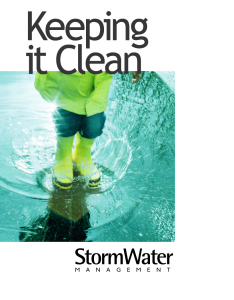Salt Your Meals, Not Your Rivers and Lakes
As winter continues, do you need to restock your supply of snow and ice control products? Before you do, think about this: even one teaspoon of deicing salt in 5 gallons of water is toxic to aquatic life. This winter, consider the environment and go on a “low-salt diet” to protect our water.
Every type of snow and ice control product can impact the environment in some way. When snow and ice melt, the residual products are washed off our paved surfaces, into the nearest storm drain, through our storm sewers, and into our lakes and rivers.
Products containing salts, or chlorides, can pollute surface water, groundwater, and soil. Salts dissolve in water where they are nearly invisible, but they do not disappear. Research conducted by the University of Minnesota and the Minnesota Department of Transportation in the Twin Cities Metro Area indicates that 78% of salts applied to pavements are retained in area water bodies. They estimate that 76% are road applications by cities, counties, and the state; but the remaining 24% comes from private and commercial applications. Chlorides can also kill vegetation, corrode metal, damage concrete, and harm pets by burning their feet and making them sick when they lick their feet.
There are other negative impacts, as well. For instance, non-salt deicers and anti-icers may contain phosphorus, which depletes oxygen in our lakes and rivers. Abrasives that reach our waterways make the water dirty, decreasing visibility and altering habitat. Many solid snow and ice control products contain traces of other unwanted chemicals, such as iron cyanide, to prevent clumping. Trace concentrations of arsenic, lead, and mercury can also be present.
As you cope with the icy facts of winter, consider your options for keeping sidewalks, driveways, and parking lots safe AND minimizing your impact on water quality. Here are some suggestions:
Always shovel or plow first. Use old-fashioned elbow grease to chip away icy patches. Manual removal of snow and ice buildup means less chemical is needed.
Carefully read labels when choosing your products so you know what’s in it, when to use it, and how much to use. Pavement temperature, not air temperature, determines when salts and other deicers can melt ice. “Regular” salt (sodium chloride) only works when pavement temperatures are warmer than 15° F. Calcium and magnesium chloride work at pavement temperatures as low as −20° F and −10° F, respectively.
Use products only where needed, such as slopes and high traffic areas, and use the right amount.
Consider using only abrasives to create traction. Abrasives do not melt ice; they only provide temporary traction on slippery surfaces when it is too cold for deicers to work. Applying abrasives with a deicer does not melt ice more quickly. In fact, abrasives can reduce the effectiveness of the deicer.
Consider using a liquid anti-icer with a handheld sprayer to prevent icing. As a rule of thumb, one gallon is enough for a 2,000 sq. ft. area. Compare that with 50-75 lbs of salt!
If using solid deicers, choose round pellets because they reach the icy surface faster. You will use less material if you use a broadcast spreader for even distribution instead of by the handful (see photo).
Deicers should not be used to “burn” the snow and ice completely off, but rather to make mechanical removal easier.
Sweep up spills and abrasives after each storm before they can be washed away as a pollutant; save them for later reuse.
If you hire a private contractor for snow and ice removal, ask them to follow these water-friendly practices.
Individuals, of course, use much less material to control snow and ice than our road crews, but their cumulative effect adds up to nearly one-fourth of the impact. Do your part to keep our waters clean and minimize chemical applications to control snow and ice this winter.
For More Information on what you can do please visit: http://www.rochesterstormwater.com
Have a comment? Join us on Facebook!
